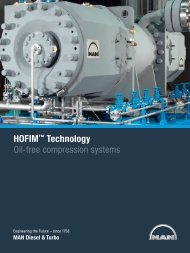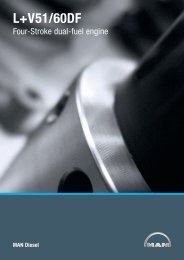Service Experience - MAN Diesel & Turbo - 首页
Service Experience - MAN Diesel & Turbo - 首页
Service Experience - MAN Diesel & Turbo - 首页
You also want an ePaper? Increase the reach of your titles
YUMPU automatically turns print PDFs into web optimized ePapers that Google loves.
Low Sulphur Fuel Operation<br />
<strong>MAN</strong> B&W low speed engines can op-<br />
erate on both heavy fuel oils (HFOs)<br />
with a varying amount of sulphur, marine<br />
diesel oil (MDO) and marine gas oil<br />
(MGO). All fuels are specified in accordance<br />
with ISO 8217 and CIMAC recommendation<br />
21. Also biofuels (with separate<br />
fuel specification) are now used on<br />
<strong>MAN</strong> B&W low speed engines.<br />
Local and international restrictions on<br />
sulphur emissions are the reason why<br />
an increased focus on low sulphur fuels<br />
is seen today. Sulphur emissions can<br />
be limited in two ways:<br />
By making rules for a maximum<br />
amount of sulphur in the fuel. Fig. 52<br />
shows the “road map” for such legislation<br />
globally and locally in so-called<br />
SECAs (Sulphur Emission Control<br />
Areas)<br />
By applying abatement technologies<br />
on board the vessels allowing the<br />
vessels to continue operating on a<br />
high sulphur content HFO. The driving<br />
force for such technologies is the large<br />
price difference between various HFOs<br />
and distillates, see Fig. 53.<br />
When running on low sulphur fuels, a<br />
number of issues of interest in relation to<br />
operational aspects can be mentioned.<br />
Many of these are dealt with in detail in<br />
our <strong>Service</strong> Letter, SL09-515/CXR, Ref.<br />
[3]. These issues are discussed one by<br />
one in the following.<br />
Catfines in Low Sulphur HFOs<br />
From a large number of bunker analyses,<br />
it can be seen that there is a tendency<br />
towards a higher amount of<br />
catfines in fuels with lower sulphur con-<br />
US$ per Ton<br />
1300<br />
1100<br />
900<br />
700<br />
500<br />
300<br />
100<br />
26 <strong>Service</strong> <strong>Experience</strong> of <strong>MAN</strong> B&W Low Speed <strong>Diesel</strong> Engines<br />
MEPC 57 IMO & CARB Fuel-Sulphur Content Limits<br />
Equivalent methods may be used as altemative<br />
Global 4.5→3.5→0.5<br />
SECA 1.5→1.0→0.1<br />
Global<br />
CARB MGO 1.5→1.5→0.1 (DMA)<br />
CARB MGO 2.0→0.5→0.1 (DMB<br />
SECA<br />
CARB Phase 1<br />
CARB Phase 2<br />
2000 2005 2010 2015 2020 2025<br />
Year<br />
5<br />
4,5<br />
4<br />
3,5<br />
3<br />
2,5<br />
2<br />
1,5<br />
1<br />
0,5<br />
0<br />
Fig. 52: Sulphur reduction ‘road map’<br />
US$ per Ton<br />
End of Period<br />
July 2009<br />
MDO<br />
380 CST<br />
85 86 87 88 89 90 91 92 93 94 95 96 97 98 99 00 01 02 03 04 05 06 07 08 09 A M J J A S O N D J F M A M J J A S O N D J F M<br />
Fig. 53: Cost difference: HFO vs. distillates<br />
March 2010<br />
tents. This requires increased focus on<br />
optimal function of the fuel treatment<br />
plants on board vessels operating on<br />
low sulphur fuels.<br />
Cylinder Lubrication and Low<br />
Sulphur Fuels<br />
It is well-established that <strong>MAN</strong> B&W<br />
low speed engines, to a certain degree,<br />
need cylinder oil feed rates proportional<br />
to the sulphur content in the fuel. This is<br />
due to the fact that we prefer to have a<br />
controlled amount of cold corrosion on<br />
Jan 2012<br />
2008 2009 2010<br />
the cylinder liner wall. However, we also<br />
have other requirements for lubrication<br />
apart from controlling the acid neutralisation.<br />
These requirements presently<br />
put a minimum limit to the feed rate of<br />
0.6 g/kWh. Fig. 54 illustrates the degree<br />
of over-additivation when operating on<br />
various cylinder oils (various BN numbers),<br />
and it can be seen that the need<br />
for lower BN cylinder oils will persist as<br />
fuel sulphur content limits are tightened.








